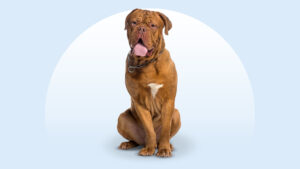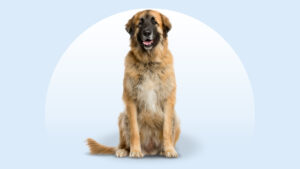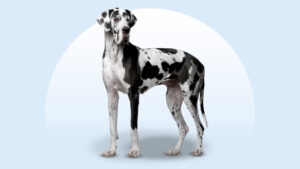Irish Wolfhound
Updated December 15, 2025
Irish Wolfhound
Updated December 15, 2025
Have an extra-large sectional sofa that’s not getting enough use? Your house is missing an Irish Wolfhound who’d love to cozy up to you on it. These extra-large pups have an impressive stature with an extra-large helping of affection and loyalty.
Affectionate, Kind, Loyal
105–120 pounds
30–32 inches
6–8 years
Gray, Brindle, Red, Black, White, Fawn
If you’ve ever dreamed of being friends with Chewbacca, you’re in luck: Being BFFs with an Irish Wolfhound, a gentle giant of the canine world, might be the next best thing. This pup will be as loyal to you as Chewy was to Han Solo.
If you’ve ever wanted to literally see eye-to-eye with your dog … this is about as close as you’re going to get. (Irish Wolfhounds are at least 30 inches tall—that’s nearly 3 feet!) And while they sometimes get preoccupied in their own little world, Irish Wolfhounds are devoted besties who might forget how big they are when they go in for snuggles; but that just makes it cozier, right?
Irish Wolfhound Characteristics
Irish Wolfhound Appearance
Strong and elegant, the Irish Wolfhound is the tallest of all the dog breeds recognized by the American Kennel Club (AKC). Even though their size might be a little intimidating, these gentle giants are lovers at heart.

- Ears
Irish Wolfhounds ears are small, folded, and thrown back.
- Eyes
Their eyes are dark and often relatively round.
- Nose
An Irish Wolfhound nose is dark with a fairly long muzzle.
- Coat Length
The Irish Wolfhound dog breed is double-coated, which means they have a soft undercoat and a wiry overcoat.
- Coat Color
Irish Wolfhound colors include gray, brindle (faint tiger stripes), red, black, white, and fawn.
- Tail
An Irish Wolfhound’s tail is long and curved.
Irish Wolfhound Temperament
These calm, friendly pups are big softies at heart. When you bring home an Irish Wolfhound puppy, you’ve found a lifelong best friend.
But despite their devotion, an Irish Wolfhound’s sight hound instincts sometimes convince them that their agenda—like napping, counter surfing, or watching squirrels—is the most important thing in the world. An experienced pet parent can teach them that sometimes it’s good to follow a healthy routine.
When trained and well-socialized, Irish Wolfhounds can adapt to life with other pets. But due to their ancestral sight hound instinct, they might not do well around cats, but this depends on the individual dog and whether they were properly introduced to feline friends.
Irish Wolfhounds generally love interacting with children but are better suited for families with older kids, as your giant pup may accidentally bump into a little kiddo or inadvertently knock them over when playing.
This calm breed is athletic and loves to run, but they can also be talented couch potatoes if you let them.
How to Care for a Irish Wolfhound
The Irish Wolfhound is a whole lot of dog—even Irish Wolfhound puppies are big compared with most other breeds.
Their size impacts everything from diet to training. But their grooming needs aren’t as outsized as their body, and Irish Wolfhounds tend to be light shedders.
Grooming
Training
Diet
Exercise
Environment
Irish Wolfhound Health
The average Irish Wolfhound lifespan is 6–8 years. Their size makes them prone to certain health conditions, and it’s important for pet parents to know that routine vet care can quickly become expensive for this big breed.
For example, Irish Wolfhounds will need greater quantities of certain medications—the same doses smaller dogs receive just won’t be effective. This is a good reason to consider pet insurance.
Here are some health issues to be aware of.
- Bloat and gastric dilatation-volvulus (GDV): Irish Wolfhounds are prone to a life-threatening condition called bloat that occurs when the stomach becomes distended with air and/or food. A serious complication of bloat is gastric dilatation-volvulus, when the stomach twists on itself, cutting off blood supply to the organs. Symptoms include abdominal distension, restlessness, excessive drooling, and dry heaving; go to the emergency vet immediately if you notice these signs.
- If you’re concerned about GDV, talk to your vet about a preventative gastropexy procedure.
- Bone cancer: More formally known as osteosarcoma, bone cancer is common in Irish Wolfhounds. Treatment often includes surgery, chemotherapy, and radiation.
- Elbow and hip dysplasia: Elbow and hip dysplasia are genetic conditions that develop during puppyhood when the joints don’t align well and become loose. Signs include limping, and treatment might involve weight loss, reduced activity, joint supplements, physical therapy, pain meds, or (in severe cases) surgery.
- Heart disease: Dilated cardiomyopathy (DCM), or an enlarged heart, is one of the most common heart diseases in large-breed dogs. When the heart enlarges, it results in thin and weakened heart muscles, leading to heart failure.
- Liver shunts: This is an abnormal series of blood vessels that bypass a dog’s liver, which can cause stunted growth, poor muscle development, disorientation, and seizures. There is no genetic screening test for liver shunts in dogs. Still, you can manage the condition with diet changes, antibiotics, other medications, and surgery.
Irish Wolfhound History
The name says it all: Irish Wolfhounds are hounds with origins in Ireland, and they hunted wolves as far back as the 1400s. Honored for centuries in Irish folklore, the Irish Wolfhound size and stature made them excellent companions on quests, battles, and general adventuring.
However, Irish Wolfhounds may have done too good of a job: Wolves were eradicated in Ireland by the 1700s. Subsequently, the population of Irish Wolfhounds diminished, and they were in danger of extinction until there was renewed interest in preserving the breed in the 1800s, according to the Irish Wolfhound Club of America. The American Kennel Club recognized the Irish Wolfhound in 1897.
The average Irish Wolfhound costs between $1,500–$3,500. If you choose this route, pick a responsible breeder.
You can also consider Irish Wolfhound adoption. Check in at a giant-breed rescue like Just Giants or Big Dogs Huge Paws, and you can also keep an eye out at your local animal shelter or search Chewy’s database of adoptable dogs in your area.








